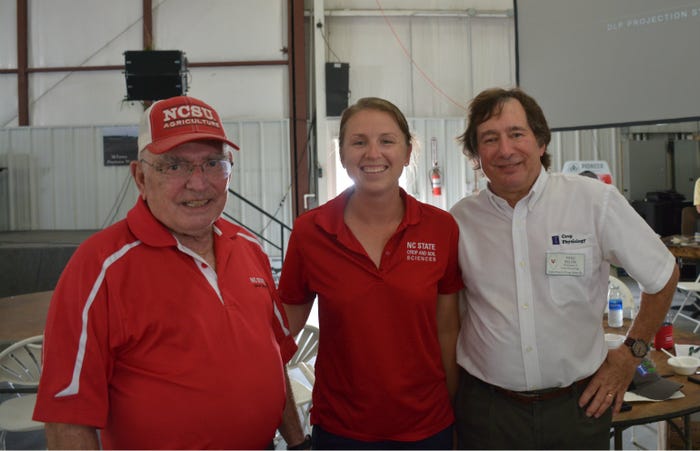
Editor's Note: This is a corrected version of the original article. Paragraph 20 has been corrected to read "The No. 4 secret is foliar protection, protecting the leaves from insects and diseases."
Farmers in Illinois are quite familiar with Dr. Fred Below’s “Six Secrets for Soybean Success.” And at this year’s Blackland Farm Mangers Tour in Pinetown, N.C., farmers in the Tar Heel State learned how Below’s practices in the No. 1 soybean producing state can work in North Carolina as well.
Below is professor of plant physiology at the University of Illinois. He has presented his “Six Secrets for Soybean Success” in farmer meetings all across Illinois. His six secrets of soybean success are:
Weather;
Fertility;
Genetics/Variety;
Foliar protection;
Seed treatment;
Row spacing.
“Weather is the biggest factor and the one you have least control over. Weather is always No. 1, but the order of the other five secrets can change depending on that year’s weather,” Below said at the Blackland Tour.
“Early planting is not one of the six secrets because it is completely determined by the weather. If you can plant your soybeans early it will help. The earlier you can plant the greater the potential yield. This is especially true if you get the rain in August,” Below said.
Fertility is No. 2. Below said that most growers aren’t adequately fertilizing their soybeans and when they are fertilizing their soybeans they are applying the wrong nutrients. The reason most farmers don’t adequately fertilize their soybeans is that soybeans get some of their nitrogen from the nodules.
Below points out that the key word is “some.” Soybeans receive about half of their nitrogen from the nodules with the other half coming from the soil and the breakdown of the previous year’s corn crop.
How many pounds of nitrogen does the soybean crop need to accumulate for every bushel?
“For corn, it’s about a pound per bushel. Soybeans need about four to five pounds of nitrogen per bushel, way more than corn. This has to do with the higher concentration of protein in the soybean seeds. It’s a huge amount,” Below said.
A 60-bushel soybean crop needs to take up 245 pounds of nitrogen over the course of the growing season. Below says that a 60-bushel per acre soybean crop removes 179 pounds of nitrogen with the seed.
Below also emphasized it is a myth that soybeans add nitrogen to the soil. “There is no such thing as a soybean nitrogen credit,” he said.
“The way most growers fertilize their soybeans is they fertilize their corn,” Below said.
When it comes to corn, the typical Illinois farmer applies 180 pounds of nitrogen per acre, 90 pounds of P2O5 per acre and 100 pounds of K2O per acre. Below said they don’t apply any sulfur or any micronutrients. Moreover, Below said, 75 percent of Illinois farmers apply no fertilizer whatsoever on their soybeans.
“This would lead me to believe that soybeans don’t require many nutrients and that would be wrong,” Below said.
For soybean fertility, it is important to remember the harvest index or the amount of nutrients the crop takes up and is removed from the crop with the grain. Below emphasized that all nutrients do not have the same harvest index value.
Based on the harvest index, the most important elements for high soybean yields are nitrogen, phosphorous and sulfur. These three have the highest harvest index of all elements. Moreover, Below said a 60-bushel soybean crop has to “suck up” almost as much potassium as does a 230-bushel corn crop and actually removes more potassium than a 230-bushel corn crop.
Below points out that 124 pounds per acre of potassium from the previous year’s corn crop is available to the soybean crop if the corn stover is left on the field. Potassium does not occur in organic form. Below said every molecule of potassium in that corn stover is available for next year’s soybean crop.
The No. 3 secret is variety and genetics. Below said that all varieties are not created equal. In a 2015 trial in central Illinois, Below compared 17 soybean varieties. The difference in yield between the highest yielding variety and lowest yielding variety was 23 bushels per acre.
Central Illinois farmers produce soybean varieties from Group 2.5 to Group IV maturity. Below said it is not a hard and fast rule, but most of the lower yields come from Group II beans. In general, fuller relative maturity beans offer a higher yield potential, especially if planted early, receive August rain and are managed.
The No. 4 secret is foliar protection, protecting the leaves from insects and diseases.
“Soybean yield is a product function of how many pods you have per acre, seeds per pod and weight per seed. A change in any of these can be responsible for a change in soybean yield. Pod number per acre is primarily a function of weather and fertility. Seeds per pod is a genetic trait,” Below said.
Sixty percent of the pods come from the middle of the soybean plant. “If you can put just one more pod on every soybean plant that is worth two bushels, which is another reason foliar protection is so important,” he said.
No. 5 is protecting the soybean seed from insects, diseases and nematodes. Treated seed is a must. Compared to naked seed, between 5,000 to 15,000 more seeds emerge per acre when treated. “Not only do more emerge, but they grow faster after they emerge. This is especially true if we plant early and have a cold, wet spring,” he said.
No. 6 is row spacing. Below said 15-inch rows generally yield better than 30-inch rows. In 15-inch rows, the soybean plant intercepts more light. The disadvantage of narrow rows in Illinois is in narrow rows it is harder to control diseases like white mold.
In his research plots, Below goes for a compromise of 20-inch rows that allow for more light interception and a bit more air movement down that row to control leaf diseases.
“You can increase soybean yield with crop management,” Below concluded. “Soil fertility, particularly phosphorous, is one of the most important factors, at least the one we are overlooking the most. There is no such thing as a soybean nitrogen credit. Soybeans do not add nitrogen to the soil. Soybeans remove more nitrogen than they fix.

Dr. Fred Below, right, presented his
About the Author(s)
You May Also Like






